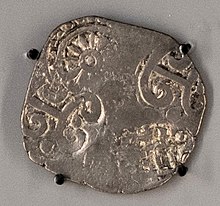Vatsa
Kingdom of Vatsa | |||||||||
|---|---|---|---|---|---|---|---|---|---|
| c. 700 BCE–c. 300 BCE | |||||||||
 Vatsa and other Mahajanapadas in the Post Vedic period. | |||||||||
| Capital | Kauśāmbī | ||||||||
| Common languages | Prakrit Sanskrit | ||||||||
| Religion | Historical Vedic religion Buddhism Jainism | ||||||||
| Government | Monarchy | ||||||||
| Maharaja | |||||||||
• 8th century B.C. | Nicakṣu(first) | ||||||||
• 4th century B.C. | Kṣemaka(last) | ||||||||
| Historical era | Iron Age | ||||||||
• Established | c. 700 BCE | ||||||||
• Disestablished | c. 300 BCE | ||||||||
| |||||||||
| Today part of | Allahabad divisionofUttar Pradesh,India | ||||||||
VatsaorVamsa(PaliandArdhamagadhi:Vaccha,literally "calf"[1]) was one of the sixteenMahajanapadas(great kingdoms) ofUttarapathaof ancientIndiamentioned in theAṅguttara Nikāya.
Location
[edit]The territory of Vatsa was located to the south of theGaṅgāriver, and its capital was the city ofKauśāmbīorKosāmbī,on theYamunāriver and corresponding to the modern-day location ofKosam.[2]
History
[edit]The early period
[edit]The Vatsas were a branch of theKuru dynasty.During the Rig Vedic period, the Kuru Kingdom comprised the area of present day Haryana/ Delhi and the Ganga-Jamuna Doab, tillPrayag/ Kaushambi, with its capital atHastinapura.During the late-Vedic period, Hastinapura was destroyed by floods, and the Kuru KingNicakṣushifted his capital and all his subjects to a newly constructed capital that was calledKosambior Kaushambi. In the post Vedic period, when Aryavarta consisted of several Mahajanapadas, the Kuru Dynasty was split between Kurus and Vatsas. The Kurus controlled the Haryana/ Delhi/ Upper Doab, while the Vatsas controlled the Lower Doab. Later, The Vatsas were further divided into two branches—One atMathura,and the other at Kaushambi.
The Puranas state that after the washing away ofHastinapuraby the Ganges, theBhāratakingNicakṣu,the great-great grandson ofJanamejaya,abandoned the city and settled inKauśāmbī.This is supported by theSvapnavāsavadattāand thePratijñā-Yaugandharāyaṇaattributed toBhāsa.Both of them have described the king Udayana as ascionof theBhāratasfamily (Bhārata-kula). The Puranas provide a list ofNicakṣu’s successors which ends with kingKṣemaka.[3]: p.117–8 Other Puranas state that the Vatsa kingdom was named after aKaśīking, Vatsa.[4]TheRamayanaand theMahabharataattribute the credit of founding its capitalKauśāmbīto a Chedi princeKuśaorKuśāmba.
TheMahabharataand theHarivansastates the close connection between the Vatsas and the Bhargas (Bhaggas).[3]: p.98
Mahajanapada period
[edit]
| History of South Asia |
|---|
 |
The first ruler of theBhāratadynasty of Vatsa, about whom some definite information available isŚatānīkaII, Parantapa. While the Puranas state his father’s name wasVasudāna,Bhāsatells it wasSahasrānīka.ŚatānīkaII married a princess of Videha, who was the mother of Udayana. He also marriedMṛgāvatī,a daughter of theLicchavichieftainCeṭaka.[5]He attackedCampā,the capital ofAṅgaduring the rule ofDadhivāhana.[3]: p.119
The wife of Śatānīka and the mother ofUdayanawas Queen Mṛgāvatī (inSanskrit) or Migāvatī (inPrakrit). She was the daughter ofChetaka,the leader ofVaishali.[6]It is recorded that she ruled as aregentfor her son for some period of time, although sources differ about the specific circumstances. According to theJaincanonical texts,Udayana was still a minor when Śatānīka died, so "the responsibility of governing the kingdom fell on the shoulders of queen Migāvatī... till her son grew old enough".[7]On the other hand,Bhāsa'sPratijñāyaugandharāyaṇasays that she took "full charge of the administration" while Udayana was held as a prisoner by KingPradyotaofAvanti,and "the way in which she discharged her duties excited the admiration of even experienced ministers".[8]Mrigavati, is notable for being one of the earliest known female rulers in Indian history.
Udayana
[edit]Udayana, the son ofŚatānīkaII by the Videha princess succeeded him. Udayana, the romantic hero of theSvapnavāsavadattā,thePratijñā-Yaugandharāyaṇaand many other legends was a contemporary of Buddha and of Pradyota, the king of Avanti.[3]: p.119
Later history
[edit]According to the Puranas, the 4 successors of Udayana wereVahināra,DanḍapāṇI,Niramitra andKṣemaka.Later, the Vatsa kingdom was annexed by theAvantikingdom. Maniprabha, the great-grandson of Pradyota ruled atKauśāmbīas a prince of Avanti.[3]: pp.180, 180n, facing 565
Vatsa was ultimately annexed intoMagadhabyShishunaga.[9]
See also
[edit]References
[edit]Citations
[edit]- ^Louis Herbert Gray (1902).Indo-Iranian Phonology with Special Reference to the Middle and New Indo-Iranian Languages.Columbia University Press. pp.169–170.
- ^Raychaudhuri, Hemchandra(1953).Political History of Ancient India: From the Accession of Parikshit to the Extinction of Gupta Dynasty.University of Calcutta.pp. 131–133.
- ^abcdeRaychaudhuri, Hemchandra (1972).Political History of Ancient India.Calcutta, India: University of Calcutta.
- ^Pargiter, F.E. (1972)Ancient Indian Historical Tradition,Chaunan, Delhi, pp.269-70
- ^Mahajan V.D. (1960, reprint 2007).Ancient India,S.Chand & Company, New Delhi,ISBN81-219-0887-6,pp.171-2
- ^Jain, K.C. (1991).Lord Mahāvīra and His Times.Lala Sunder Lal Jain research series (in Latvian). Motilal Banarsidass. p. 67.ISBN978-81-208-0805-8.Retrieved16 July2018.
- ^Jain, J.C. (1984).Life in Ancient India: As Depicted in the Jain Canon and Commentaries, 6th Century BC to 17th Century AD.Munshiram Manoharlal. p. 470.Retrieved16 July2018.
- ^Altekar, A.S. (1956).The Position of Women in Hindu Civilization, from Prehistoric Times to the Present Day.Motilal Banarsidass. p. 187.ISBN978-81-208-0324-4.Retrieved16 July2018.
- ^Upinder Singh 2016,p. 272.
